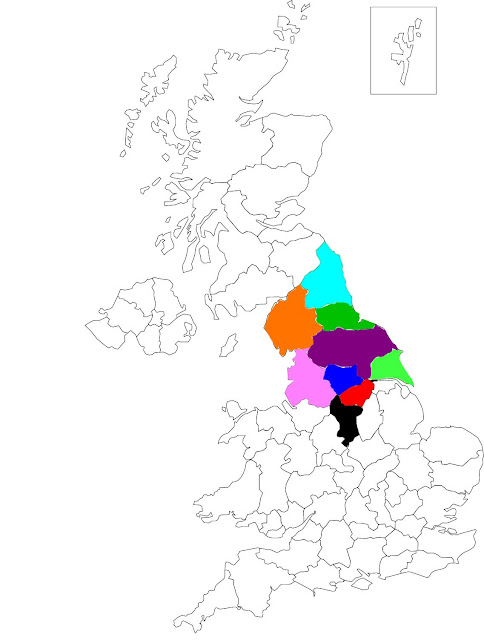In a previous blog I looked at the counties of Wales and
where the archives for these counties were found. I did this as when
researching family history we sometimes need to visit an archive to find out
some information that cannot be found online. So I thought I’d put together a
list of the counties of the UK with the location of their main archives for the
county. This blogs is the first of 5 parts based on the counties of England.
I’m starting at the top and working my way down.
 |
| Counties of England (codes denote places) |
Northumbria or Northumberland (Light Blue)
Situated in the extreme north east of England Northumbria.
It partly encompasses Tyne and Wear so you need to remember this when document
locating. The population of Northumbria is around 330,000. The county town is
Alnwick. The archive for the county is located in Ashington and also there is a
record office in Berwick upon Tweed. The website for the county can be found
at: https://www.northumberlandarchives.com
You may also need the Tyne and Wear archives in Newcastle
upon Tyne which can be found at: https://twarchives.org.uk/
Cumbria (Orange)
Cumbria boarders Scotland to the north and is in the extreme
north west of England. The population of the county is approximately 500,000
with the county town being Carlise. The main county archives are housed in
Carlise and there are also branches in Whitehave, Kendal and Barrow. The
website can be found at: https://www.cumbria.gov.uk/archives/
County Durham (Dark Green)
County Durham is in the north east of England and has a
population of approximately 863,000. The county town is Durham and the archives
for the county are held here as well. The website address is: http://www.durhamrecordoffice.org.uk/article/8338/Home
Lancashire (Pink)
Again this is a county that has several regions. It is
located in the north west of England. Lancashire encompasses Greater Manchester
and Merseyside. Lancashire it’s self has a population of around 1.5 million.
The county town is Lancaster and the archives are in Preston. The website can
be found at: https://www.lancashire.gov.uk/libraries-and-archives/archives-and-record-office/
You may also need the Manchester archive at: https://www.manchester.gov.uk/info/448/archives_and_local_history
and the Liverpool archives at: https://liverpool.gov.uk/libraries/archives-family-history/
Yorkshire
The largest of the counties of England. It is split into 4
counties these days, but it used to be 3 ridings. York is the major town of
Yorkshire as a whole. The entire population of the county is around 5.4
million.
North Yorkshire (Purple)
The most northerly of the counties of the best county in the
country, Yorkshire. North Yorkshire has a population of around 1.2 million. The
county town is Northallerton. The archives for the county can be found in
Northallerton and the website is: https://www.northyorks.gov.uk/county-record-office
You will also need to consider the archives in York who’s website is: https://www.exploreyork.org.uk/archives/
and don’t forget the Bothwick Institue a part of York University at: https://www.york.ac.uk/borthwick/
West Yorkshire (Dark Blue)
As the name suggests the westerly region of Yorkshire, which
in the past included South Yorkshire. The population of West Yorkshire is
around 2.3 million and the county town is Wakefield. The archives for the
county are spread over 5 locations in Wakefield, Leeds, Calderdale, Bradford
and Kirklees. The website for the archives is: https://www.wyjs.org.uk/archive-service/
Also don’t forget you may need the archives in York as well (see North
Yorkshire).
East Yorkshire (Light Green)
The easterly county of Yorkshire and at one point part of
the county fell under Humberside. East Yorkshire has a population of around
600,000 and the county town is in Beverley. The archives for the county can be
found in Beverley and the website is: https://www.eastridingarchives.co.uk/
again you may need the archives in York (see North Yorkshire).
South Yorkshire (Red)
The south region of Yorkshire which used to fall under West
Yorkshire. The population of the region is around 1.4 million. The county town
is Barnsley (I thought it was Doncaster and I lived in the county for 27
years). There is no central archive for the county rather you have to go to the
major towns and cities archives. Sheffield archives: https://www.sheffield.gov.uk/home/libraries-archives/access-archives-local-studies-library
, Doncaster: https://library.doncaster.gov.uk/web/arena/archives
,Rotherham: https://www.rotherham.gov.uk/info/200062/libraries/718/archives_and_local_history
, Barnsley: http://www.experience-barnsley.com/archives-and-discovery-centre
. Also you may need the archives in York (see North Yorkshire) and Derbyshire
as part of Sheffield used to be in Derbyshire.
Derbyshire (Black)
The most southerly county in the section. Derbyshire
boarders South Yorkshire. The population is around 1, 050,000 and the county
town in Derby. The main archive for the county is in Matlock and the website
is: https://www.derbyshire.gov.uk/leisure/record-office/derbyshire-record-office.aspx
In all of these counties don’t forget the local family
history societies as well as the local libraries. These are also excellent
sources of information.
So hopefully this will help you in locating where the
information you need may be stored.




No comments:
Post a Comment